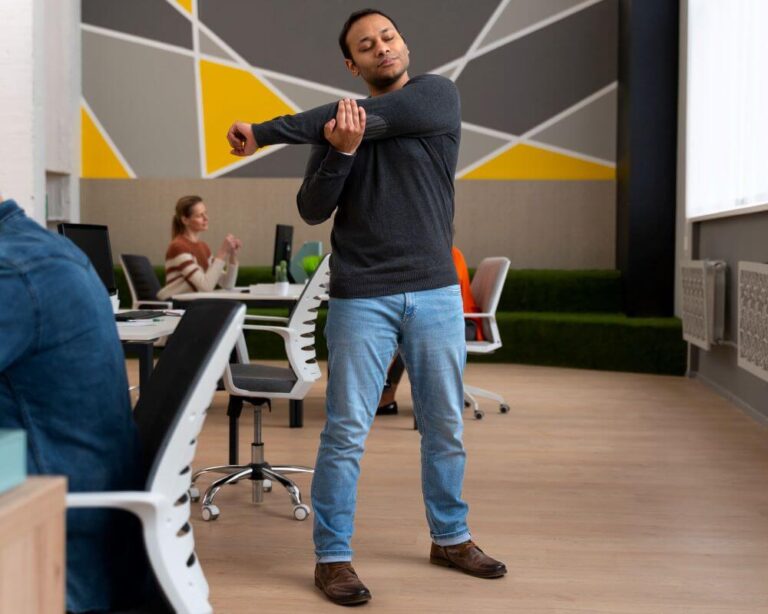Most people don’t associate office jobs with danger, but workplace injuries aren’t confined to factories or construction sites. Desks, corridors, and break rooms often conceal hazards that can lead to painful, long-term consequences. Whether it’s poor posture, repetitive motions, or unnoticed spills, the office environment carries risks that too many workers overlook. By identifying the most common threats and making a few thoughtful adjustments, employees can reduce their chances of being sidelined by preventable injuries.
Slippery Surfaces and Sudden Falls
Wet floors near entryways, freshly mopped tiles, or spilled beverages in the break room can quietly become serious hazards. One of the most frequent incidents in office settings involves a slip and fall, which may seem minor at first but can result in sprained wrists, broken bones, or head injuries. These types of accidents often happen in a split second, when someone is walking too quickly or not expecting the floor to be slick. Proper signage, prompt clean-ups, and appropriate footwear can go a long way toward making these spaces safer. In case this happens, having a lawyer is essential.
Repetitive Strain from Poor Ergonomics
Spending hours at a desk with an awkward chair, an incorrectly placed keyboard, or a monitor that sits too high or too low gradually takes a toll. Wrist pain, neck tension, and lower back discomfort are just a few of the symptoms that can result from repetitive strain injuries. These conditions creep up slowly, often starting with mild irritation that becomes chronic pain if ignored. Adjusting chair height, using a mouse that fits comfortably in the hand, and positioning screens at eye level can make everyday tasks much less damaging over time.
Eye Strain and Headaches from Screen Exposure
Constant exposure to screens is unavoidable in many office settings. Staring at monitors for extended periods can lead to digital eye strain, characterized by dry eyes, blurred vision, and headaches. The issue becomes worse in spaces with poor lighting or strong glare. Taking short breaks every 20 minutes to focus on something 20 feet away for 20 seconds—known as the 20-20-20 rule—can provide relief. Adjusting brightness, using screen filters, and positioning desks to minimize direct glare can also help reduce strain.
Back and Neck Issues from Sedentary Habits
Sitting for prolonged periods restricts movement and places stress on the spine. Over time, poor posture and minimal activity contribute to muscle imbalances, herniated discs, and stiffness in the neck and shoulders. Standing desks and ergonomic chairs can improve alignment, but the most effective remedy is consistent movement. Stretching during short breaks and walking during phone calls are simple ways to keep the body active throughout the day. Moving a regular part of the routine helps prevent stiffness from turning into a serious issue.
Injuries from Falling Objects or Cluttered Spaces
Offices can quickly become hazardous when items are carelessly stored or walkways are obstructed. Stacked files, loose binders, unstable shelving, and tangled cords all contribute to the risk of trips, falls, or being struck by falling objects. A top-heavy box placed on a high shelf might not seem dangerous until it shifts and lands on someone reaching below. Overstuffed storage areas and neglected common spaces increase the likelihood of someone stumbling or pulling something down unintentionally. Even personal workstations can become risky when under-desk cords, bags, and boxes are left scattered in footpaths. The more cluttered an office becomes, the harder it is to respond quickly to hazards or escape in an emergency. Creating clear pathways, storing heavy items at waist level or lower, and routinely checking shelves for stability are effective steps toward prevention. Encouraging a culture of organization helps keep every corner of the office safer, reducing the chances of an avoidable injury disrupting the day.
Stress-Related Physical Health Issues
Though often overlooked, stress plays a significant role in physical health within office environments. High-pressure workloads, tight deadlines, and poor work-life balance can lead to insomnia, high blood pressure, and even cardiovascular problems. Stress can also increase muscle tension, leading to chronic pain. Encouraging reasonable workloads, allowing time for breaks, and offering support for mental well-being aren’t just morale boosters—they help reduce physical health risks as well. Offices that promote a balanced and supportive atmosphere create conditions that support both mental and physical safety.
Office injuries may not always be dramatic, but their impact can be deeply disruptive. From slipping on a wet floor to silently developing back pain from poor posture, the threats are subtle but real. Recognizing these dangers and addressing them with practical solutions creates a workspace where health and productivity go hand in hand. A safe office isn’t just about avoiding accidents—it’s about creating an environment that respects the long-term well-being of those who work there every day.


